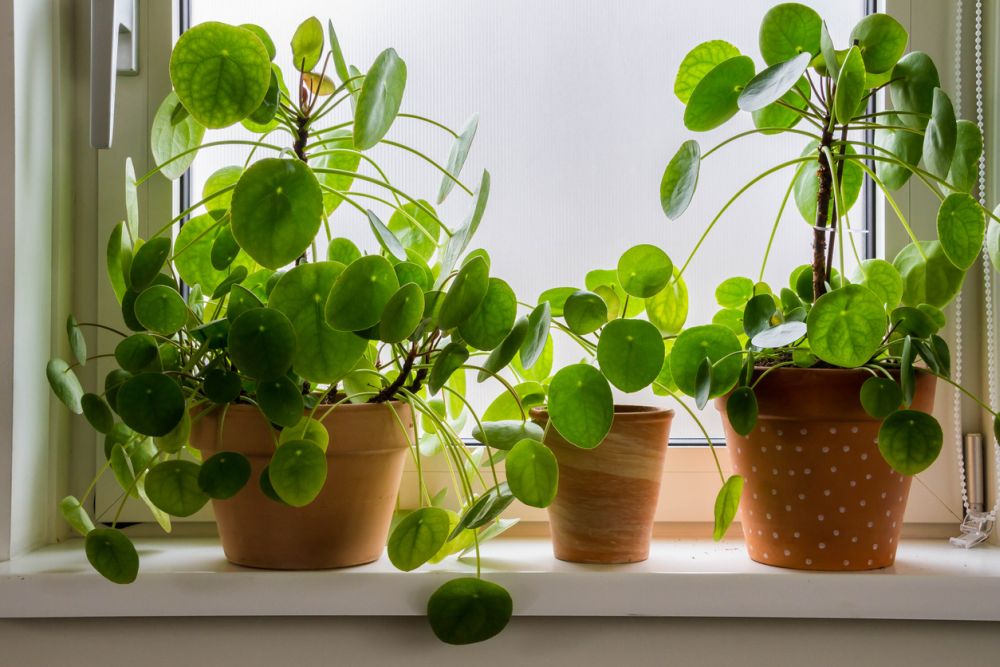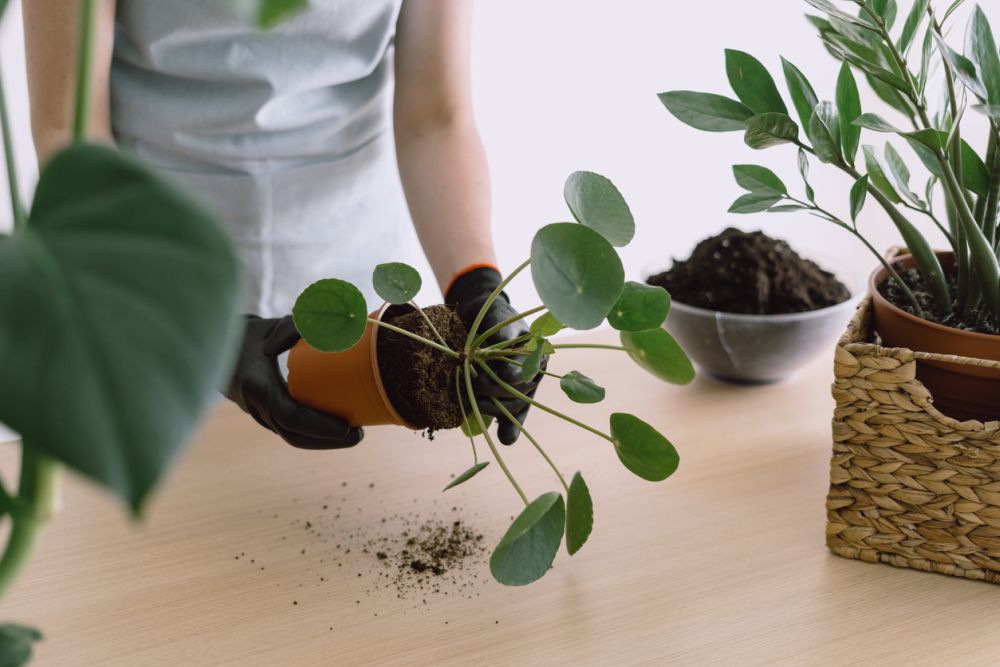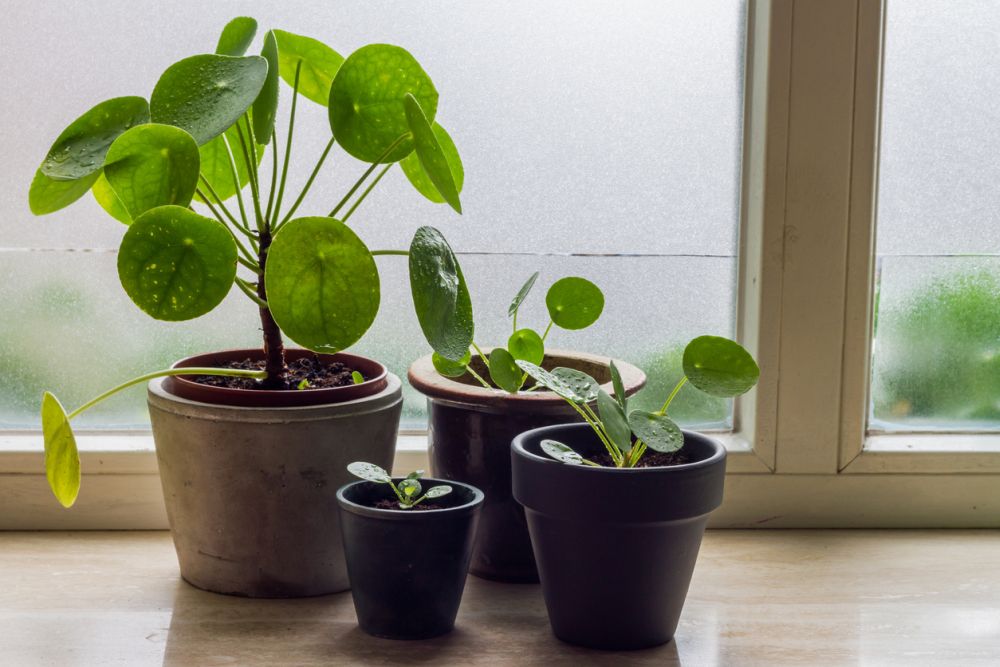How to Repot a Money Tree Even If You Don’t Have a Green Thumb
Repotting a money tree (Pilea peperomioides) is daunting for someone new to gardening, but it doesn’t have to be with the right guidance. Read on to discover the correct way to repot a money tree plant.
This guide provides the necessary supplies and step-by-step instructions for repotting your money tree easily and successfully. You will also learn the most common reasons for transferring money plants to new containers, caring tips to help the money tree recover from transplant shock faster, and more helpful information.
When should I repot my money tree?
Check out the most common reasons for repotting your money plant:
- It looks sickly: Healthy money trees are tall and vibrant, with abundant glossy leaves. A drooping and limp-looking money tree should be repotted soon.
- Overdeveloped roots: Roots peeking out of the drainage holes or popping up around the sides of the pot indicate that your money tree is root-bound, so you should transfer it to a larger pot.
- Top-heavy and easy to tip over: The top part of money plants grows proportionately to the roots. A top-heavy plant and easy to tip over shows that it’s root-bound, so it’s time to move it to a bigger pot.
- The soil dries up too quickly: A pot filled with more roots than soil won’t be able to retain water. A money plant that requires more watering than normal because the soil dries up fast indicates a root-bound money tree, so you must move it to a bigger container.
- Waterlogged soil: An outgrown root system takes up the entire pot and compresses the remaining soil. So the water remains on the pot’s surface because the soil is too compact to absorb it. In this case, the money tree is root-bound and must be repotted.
- No new growth: Another side-effect of root-binding is a nutrient deficiency. If your money tree doesn’t seem to grow anymore, it’s likely because it requires fresh, nutrient-rich soil.
- Broken pots: An outgrown root system may alter the shape of a plastic pot and even crack a terracotta or ceramic pot because it needs room for new roots. It indicates a root-bound money tree that must be repotted to a larger container.
- Mineral salt build-ups: Synthetic fertilizers may cause mineral salts to accumulate in the soil, harming your money tree. So it’s necessary to repot the plant in order to replace the soil.
- Root rot: Overwatering and other money tree caring mistakes may cause root rot. The only way to treat root rot is by trimming the damaged parts of the root system, which automatically means repotting.
- Infestations: Money trees are susceptible to fungus and pest infestations, such as spider mites, brown scale, or mealy bugs. The best way to get rid of pests and diseases is by changing the soil, so you must repot your money tree plant.
Supplies for repotting a money tree
- A new pot one or two sizes bigger than the current one. It should have at least one drainage hole since money trees need excellent drainage.
- Porous material to further improve drainage. For instance, use pebbles, clay pellets, or gravel.
- Fresh potting mix to replace the soil of the money plant. For example, use sandy, peat-moss-based soil.
- Gardening gloves to keep your hands clean.
- Shears or snips to trim away any damaged parts of the money tree.
- Tarp or newspaper to prevent making a mess on the working surface.
- A watering can to give your money tree a good watering right after repotting. This is completely optional, though.
- Fertilizer (optional) to help the money tree recover faster after repotting.
How do I repot a money tree?
Check out the step-by-step instructions for safely repotting a money tree:
- Choose the best time to repot a money tree: Postpone repotting until mid-spring or early summer when money trees wake up from their dormant stage. They will have plenty of time to recover from transplant shock during their natural growing season.
- Make preparations: Thoroughly water your money plant the night before repotting it to loosen up the soil. On the day of repotting, lay the tarp or newspapers in the working area.
- Remove the money tree from its pot: Put on your gardening gloves and lightly grab the money tree by the base of the stem using one hand, close to the soil level. Use your other hand to turn the pot upside down, allowing the plant to slide out slowly. Run a knife or a trowel along the pot’s rim if it doesn’t budge. Take care not to force the plant out by pulling on the stem since money trees are extremely sensitive. If the plant is too big to handle its pot, lightly dig out the soil until the money tree loosens up, careful not to break the roots.
- Clean up the root ball: Check the root ball for sick, damaged, or dead roots and the root-clinging soil for pests or fungi. Untangle the roots using your fingers and cut away any affected area with a trimmer.
- Trim the roots (optional): To keep your money tree to the same size, cut some healthy roots, but no more than a quarter.
- Prepare the new pot: If you have trimmed the roots, keep the old pot if it’s not damaged and the right size. Add a layer of porous material to the pot’s bottom. Next, add enough potting mix so the plant’s root ball will sit about an inch under the pot’s rim.
- Add the money tree to the pot: Place the money tree inside the pot on top of the soil mix added earlier and center it. Use one hand to hold the plant straight and the other to add the remaining soil until you fill the empty space. Gently tamp the soil so it becomes firm but not compact, leaving an inch of space on top for watering.
Tips for managing money tree transplant shock
Money trees go through transplant shock for 3-4 weeks after repotting them, which is a shared trait of all repotted plants. The plants may seem to die during this time due to dropping, falling, or yellow-turning leaves. To help money plants manage transplant shock easier, it’s best to recreate the same conditions before repotting. Here are the ideal caring conditions:
- Watering: Thoroughly water your money plant immediately after repotting it, so it trickles through the drainage holes. Subsequently, water the plant once a week when the topsoil is dry.
- Lighting: Place your money plant in bright, indirect sunlight, avoiding drafts.
- Temperature and humidity: Maintain at least 50% humidity and 65-80° F (16-26° C) temperature for your money plant.
- Fertilizing (optional): Give your money tree a nutrient boost using fertilizer but only if the plant is already used to regular fertilization.
By following money plant caring conditions, you will likely reduce the transplant shock period to 2 weeks.
FAQs
Discover more useful info about repotting money trees:
What type of soil does a money tree need?
Money trees prefer well-drained soil. Sandy, peat-moss-based soil is ideal.
Can I use regular potting soil for my money tree?
No, you shouldn’t use regular potting soil for money trees. It will cause root rot since it doesn’t drain water well. Instead, make your own mix. For instance, combine 2 parts loamy soil, 1 part peat moss, 1 part sand, and 1 part pumice.
Does a money tree like to be root-bound?
Money trees can tolerate being root-bound, although this will limit their growth. To avoid overgrown roots damaging the pots or pushing the money trees out of their containers, consider trimming up to 25% of their roots every 3 years.
Closing thoughts
Repotting a money tree is essential for ensuring it stays healthy and vibrant throughout the years. That is why you must know how to do it the right way. Follow the steps outlined in this article and pay attention to your money tree’s needs during its recovery period.


